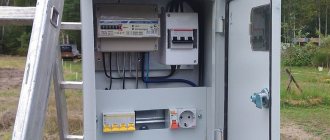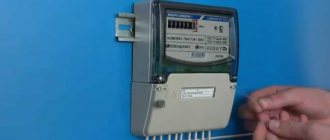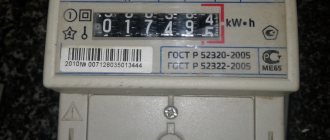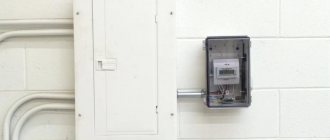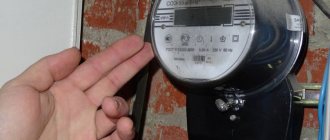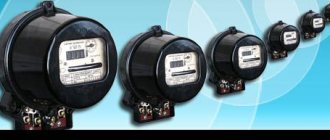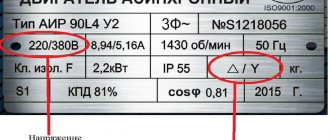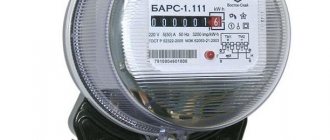How does a three-phase electric meter differ from a single-phase one?
Modern people cannot do without electricity, and, perhaps, in modern homes it is no less important than water supply or, for example, gas. Without light and electrical energy, many activities are unthinkable; most items in the house do not work. These include stoves, light bulbs, heating, electrical appliances, and even musical instruments. The energy consumed, of course, must be taken into account and controlled. This is why electricity meters are needed in premises. How to choose them, how does a three-phase electric meter differ from a single-phase one?
Connection diagram
Any connection of a single-phase electric meter must be agreed upon with the controlling organization, checked and accepted by their employees. The meter must be connected with four wires:
- Terminal 1 - connection of the input phase wire.
- Terminal 2 - connection of the output phase wire, goes to a circuit breaker or plug-type block. From it to the consumption load.
- Terminal 3 - connection of the neutral wire from the electrical network (cannot be connected to the grounding of the box).
- Terminal 4 - connection of the neutral wire to the load (connection to the ground wire of the box is allowed).
Phase input wires are red or brown and are designated by the letter - L. Neutral wires are blue, designated by the letter - N. Grounding wires are green, yellow or yellow-green and the letters PE. The grounding wire must be connected to the body of the box connected to the ground loop. It must be connected to the grounding terminal of each outlet.
What are these counters?
Single phase electricity meter
- this is a special device that is installed exclusively in a two-wire network with alternating current and a standard voltage of 220 volts.
As for the three-phase meter
, it was created for the same purposes - monitoring consumption, accounting for electricity, but in three-wire networks (and four-wire) with a frequency of 50 Hz. The current here is also variable, the voltage is 380 volts.
Types of three-phase electricity meters
Among three-phase electricity meters, there are several options. They are divided by type of functioning, scope of application, design.
By type of operation
According to the method of work there are:
- single-tariff three-phase meter;
- three-phase two-tariff metering device.
A single-tariff electric meter is suitable for houses, apartments, and industrial production. It does not provide the ability to change the tariff plan at a set time.
A three-phase multi-tariff meter is installed in those houses where the voltage needs to be distributed over several phases. Electricity at night is supplied at a reduced rate. It is connected at enterprises or in private houses with electric heating. You can connect it in a regular apartment. This will be beneficial if you are willing to use powerful electrical appliances (washing machine, dishwasher...) at night.
Read details about the benefits of multi-tariff electricity meters.
A three-phase multi-tariff device is sometimes equipped with a remote control. It allows you to quickly switch operating modes if the device does not automatically do so.
By design
The multi-tariff counting controller can be mechanical or electronic. A mechanical counter is also called an induction counter. It works on the principle of converting electrical energy into mechanical energy. The position of the equipment arrow changes. If all sources of consumption in the house are turned off, the position of the arrow of a three-phase mechanical device will return to zero. Induction electricity meter is used less and less.
The electronic controller is equipped with a digital monitor on which the readings are displayed. May differ from mechanical only in appearance. The workmanship remains the same.
To install the device outside the home, you should choose a street meter. It is practical and adapted to different climatic conditions. This option is also resistant to seasonal changes in air temperature.
By connection type
There are metering equipment of direct and indirect connection. Direct connection meters are designed to control the electricity consumed by low-power consumers. The measurements are carried out by an internal circuit. It is connected to a three-phase alternating current network with four conductors.
When connecting a three-phase electricity meter with indirect connection, it is necessary to have a transformer in the circuit. Suitable for mounting high-power electrical circuits. Several methods can be used for connection:
- star;
- ten conductors;
- connection of voltage and current circuits;
- test terminals.
When using a multi-tariff indirect meter, two circuits are formed: primary and secondary. One is made of thick conductor. It passes through the transformer and plays the role of a core. Current wires are connected to its ends. The secondary winding supplies power to the converter. It is made in the form of coils of conductor with a small cross-section. The result is a finished transformer. It is mounted for each phase. The overall structure is placed in a shield.
Where and what kind of counters are used?
Understanding how a three-phase electric meter differs from a single-phase one, it is necessary to find out the scope of their application. Single-phase devices are usually installed in residential buildings and neighborhoods, as well as in most office and administrative buildings, garages, retail outlets, cottages, and country houses. Single-phase meters are very simple and logical and easy to use. For example, it is easy to take all the necessary readings from them. Such devices transmit single-phase current and have a special “CO”
.
Three-phase meters are much more complex in design, much more accurate in measurement and are needed mainly in facilities that are highly complex, that is, industrial facilities, enterprises, buildings that consume huge amounts of electricity. To power such meters, three-phase power is required. They are also installed when there is no neutral wire in the building: there are three-wire meters for this. If there is a neutral wire, then take a four-wire one. Such devices are marked “ST”
.
Advantages and disadvantages
The only significant disadvantage of electronic meters compared to induction ones is their low protection against lightning discharges, which leads to their failure with data loss. Induction devices with a mechanical counter are free from this disadvantage. This is the reason why in many organizations, along with electronic meters, mechanical meters remain for additional control in order to avoid data loss in emergency situations, especially in the summer during thunderstorm activity.
Electronic meters have a number of advantages over induction ones. Microcircuits of electric meters are capable of storing information that cannot be erased from the moment of its manufacture. Even after the electricity meter fails, you can read data from the microcircuit and have information about electricity consumption at any time. Electric meters have a higher accuracy class and record high-speed power changes, and also take into account low loads during powerful sudden surges.
In addition, they have the ability to keep track of consumption according to a multi-tariff schedule, and record the date and time of electricity consumption. Electricity meters keep track of the quality of supplied electricity at a given time. Voltage, frequency and time are recorded. Based on these data, one can judge the quality of compliance with the contract on the part of not only the consumer, but also the energy supply organization.
Electric meters record and store data of both active power consumption and reactive power. The information is stored in the non-volatile protected memory of the device and can be displayed on a special adapter through a convenient interface. Any attempt of unauthorized access to the device’s memory data, an attempt to reset it, or the introduction of additional elements into the conversion circuit is recorded in memory indicating the date and time, which more effectively protects the meter from theft of electricity.
It is almost impossible for even a highly qualified specialist to steal through any attempts to change the connection or change network parameters without the ability to detect this attempt. This negates the possibility of electricity theft with timely monitoring.
Electronic meters have the ability to read information remotely and warn of attempts of unauthorized access to the device. It is possible to program according to a multi-tariff plan, taking into account time, holidays and weekends. Electric meters are much more compact and smaller in size, allowing them to be mounted in small electrical boxes along with other mobile equipment. The service life of electric meters from many manufacturers is more than 30 years. Verification intervals from 10 to 16 years.
Which counter should you choose?
Having figured out how a three-phase electric meter differs from a single-phase one, you can easily choose the best model for yourself and not be surprised by the seller’s question “What kind of meter do you need?” The only thing to remember is that the purchased device should only be installed by a professional electrician. If you do not have the proper qualifications, you should not undertake the installation of such a device under any circumstances. After installation, the meter is sealed by a representative of the electricity supplier company. For a three-phase circuit, you can only buy a three-phase meter.
But there is a single-phase circuit, and a more powerful meter was purchased by mistake, nothing bad will happen. The fact is that three-phase devices can be connected to a single-phase network.
General information
A three-phase electrical network simplifies the creation and operation of electrical machines, such as, for example, the asynchronous motor, which has become the basis of many industrial machines. All residential buildings are connected to a three-phase alternating voltage network , and the owners of most private buildings use 380 volts to electrify their properties.
The compatibility of an industrial three-phase electrical network with a household one is associated with several options for consumer connection schemes. Thanks to this, consumers can use either 220 volts or 380 volts and distribute the load between the phases.
As a rule, a three-phase electrical network is four-wire - three linear wires and one zero. In linear wires, the voltage phase is consistently shifted by 1/3 of the period. To distinguish them from each other, they are designated by the letters A, B and C or L 1, L 2, L 3 and have different standardized color markings. So, in Russia, Kazakhstan, Ukraine and China, phase A is yellow, phase B is green, C is red, zero is blue or cyan.
In addition to the four current-carrying wires of a three-phase network, there is a fifth one - grounding, which protects consumers and people from emergency operation of electrical appliances.
When connecting any devices to a three-phase power supply, the phase sequence must be observed. You can navigate by the color marking of the conductors, but for control you need to use a special device - a phase indicator.
What kind of lighting do you prefer?
Built-in Chandelier
Is it worth buying a three-phase meter for a single-phase network?
Having found out how a three-phase electric meter differs from a single-phase one, many may decide to buy the first one. But is it worth doing? The question is complex and sensitive. The thing is that the distribution current for a three-phase device is much greater than for its less powerful brother. In small houses and private buildings this is simply inconvenient. In addition, a three-phase meter is much more dangerous, because the voltage is higher, which means the current in the event of a short circuit will be much greater. In addition, in order to connect a three-phase device, you will have to work hard to obtain all the necessary documents and permits from the energy sales office. But on the other hand, with a three-phase meter, you can easily connect a whole network of powerful devices (for example, heaters, boilers) to your home without fear of overloads and phase imbalances. The owner of the building will not encounter too low voltage in the network, but he will have to be much more attentive to the issue of electrical safety of his property.
Popular models in Russia
Three-phase electricity meters of several brands are distinguished by good performance: Incotex, Taipit, Energomer.
Mercury 230 AM-03
A reliable device that can last up to 30 years. Suitable for installation in houses or apartments.
| Power consumption, W/V*A | 1/8 |
| Calibration interval, years | 10 |
| Operating temperature range, °C | -40-+55 |
| Accuracy class | 0.5S-1 |
| Maximum current | 5/7,5-5/60; 10/100 |
| Energy measurement sensitivity | 0,005-0,02/0,025 |
The data in the table is given for direct and transformer-connected metering devices.
Mercury 231 AT-01I
Multi-tariff controller for measuring consumed kW. Can work autonomously. Complies with GOST R 52322.
| Accuracy class | 1 |
| Maximum current, A | 60 |
| Rated current, A | 5 |
| Rated voltage, V | 3*230/400 |
| Calibration interval, years | 10 |
Typeit NEVA 303 1S0 230V 5(60) A 5(60) A
Electromechanical metering device. Used for one tariff. It has good technical characteristics.
| Accuracy class | 1.0 |
| Rated current, A | 5 |
| Maximum current, A | 60 |
| Connection principle | Direct |
| Minimum/maximum frequency, Hz | 47,5/52,5 |
By tariff
But if the choice based on technical characteristics is quite simple for the average user, then some features of modern electricity metering devices can puzzle even an experienced electrician, so it is necessary to familiarize yourself with the typical set of functions of a particular metering device.
there is accounting
- single tariff
— two-tariff
- multi-tariff
The main feature of multi-tariff metering is the difference in the cost of electricity at different times of the day.
The multi-tariff system is beneficial to those who, for example, have electric heating. Thus, it is possible to program the boiler controller so that the peak heating of the premises occurs at night, and during the day the boiler operates at minimum power. For those whose consumption is even throughout the day, a multi-tariff system is often unprofitable. After all, as a result, the amount to be paid remains approximately the same as at a single tariff.
there are following solutions
Three-phase power: advantages
The presence of three phases brings a lot of advantages to the owner of a private house or cottage. Here are some of them:
- Increased capacity
Every year the number of household electrical appliances in each home increases, which means their total power and the load they transfer to the electrical grid increase. Today in Russia, local Oblenergos offer the opportunity to draw up a contract for the consumption of 5 kW for single-phase networks and 15 kW for three-phase networks.
Let's assume you have one phase and the total power of all electrical appliances in your house is 4 kW. But time passed, and you decided to buy yourself a 3 kW welding machine. By the way, you can read about which welding machine to buy here. In this case, the total power will be 7 kW, and you will not be able to use all devices at the same time. And if in the future you plan to install pumping equipment or an electric heating system, then you should think about connecting a three-phase network.
- Even load distribution
Thanks to the operation of three phases simultaneously, it is possible to evenly distribute the load between them to avoid distortion. For example, if you regularly weld in the garage, it is best to do it on a different phase to which the TV, computer equipment or light bulbs in the house are connected. You can calculate the load for each household appliance and distribute them proportionally across phases.
There are also cases when, due to increased load (not through your fault), the voltage drops to 170 V or even lower on certain phases. This often happens if the house is located at a great distance from the transformer substation, and there are dozens of other consumers in front of it. In this case, the equipment can be temporarily switched to a less loaded phase, and when the imbalance “goes away”, everything can be returned to its place.
- Operation of three-phase equipment
Although most household appliances operate on 220 V, there is still equipment for three-phase networks of 380 V. The following types of such equipment can be distinguished:
- Pumping stations. Some deep and surface pumping stations require 380 V.
- Transformer welding machines.
- Heating boilers. Most electric heating boilers have a rated power of 7 - 9 kW - a single-phase network simply would not cope with it. For example, for a single-circuit boiler EVAN Warmos-IV-9.45 with a power of 9.45 kW, three phases are required.
- Possibility of installing automatic circuit breakers and RCDs with lower nominal values
Due to the fact that each phase wire in a three-phase network will have a lower load than on one phase in the case of a single-phase input, it is possible to install circuit breakers and RCDs with lower current loads. For example, if devices with a total power of 3 kW are placed on each phase, then each phase will require an automatic machine capable of withstanding such a load:
3000/220 = 13.6 A (phase load)
The closest machine is rated at 16 A. For single-phase power supply with a maximum possible power of 5 kW, you will need a more powerful machine. The same rule applies to residual current devices. We have already written about how to choose an RCD based on power, so we will not dwell on this.
By case type
Depending on the design of your electrical panel and the installation location of the electric meter, you need to decide on the type of its housing. offers three options:
— For mounting on a DIN rail.
— Needed by those who have a meter installed in a panel on a support.
— For installation on a flat surface.
— Such devices have a three-bolt mount. They are suitable if you want to replace an old plug meter that was installed on a flat metal plate or in a floor panel.
- Universal.
— For mounting both on a flat surface and on a DIN rail.
But if you unknowingly bought a DIN-rail meter to replace an old three-bolt meter, don’t despair. You can purchase an additional DIN rail separately or buy a special mounting rail for the three-phase meter SKAT article mp-300; they can be either universal or special for certain models.
CE brand meters are available in different versions, and the housings are marked with letters. Thus, for conventional electrical panels, housings of type S or Ш (mounting on a flat surface), and for mounting on a DIN rail, housings of type R or P are suitable.
How to do installation
The electricity meter for each apartment in high-rise buildings is connected either in a common corridor or in the apartment individually. For private homes, the device can be installed directly on the street. How exactly the connection will take place depends on whether new wiring is being connected or whether a failed meter has to be replaced.
Important! Before you start working on the electrical panel, you need to install switches at the entrance to it, with which you can turn off the power. It must also be sealed.
To dismantle, you must perform the following steps:
- First of all, you need to take care of safety and completely turn off the input power;
- seals are removed from the meter;
- remove the cover covering the terminals;
- wires are disconnected.
Important! When disconnecting the meter from the network, you must first check the voltage again to protect yourself from electric shock, and only then disconnect the wires. The check can be done using a tester, a multimeter or a screwdriver with an indicator.
Source zgbox.ru See also: Catalog of companies that specialize in electrical work.
Once all these steps have been completed, you can safely remove the device from the wall. Installation work is done exactly the opposite. The meter is attached to the place where the old one stood, and the wires are connected to the terminals. The terminal block is closed with a lid, seals must be placed and the voltage is turned on. In order to check whether the work was carried out correctly, you need to plug in electrical appliances. If the kilowatt-hour countdown has begun, then everything has been done without violations and in accordance with the standards.
Installing the meter in a new location will require more time and labor. It is recommended to mount it near the entrance doors. The shield must also be installed. When choosing it, you need to take into account that there will also be a circuit breaker and a device that will operate in case of danger.
The sequence of work will be as follows:
- As soon as the place where the meter will be fixed is designated, you need to use a drill to make several holes in the wall, and dowels are inserted into them. After this, the shield is screwed to the wall. This is done using screws.
- The counter itself is placed on the shield. There are special DIN rails for this. With their help, you can also attach a circuit breaker, as well as an RCD, to the panel.
Before starting work, a detailed plan is drawn up. Source museblog.ru
- The next step is to connect the wires to the terminals. First of all, connect the output wiring. And these are the second and fourth terminals. After this, you need to connect them to the circuit breaker, which will supply voltage to the consumption points.
- And only after connecting the internal wiring, the input is connected. At the end of the work, the terminals are closed with a lid and sealed.
Most often, users for such work call special services, which, in fact, are obliged to do dismantling and installation. But there are also cases when you can wait a very long time for installers and the consumer does this simple work on his own. In this case, you can find yourself in an unpleasant situation, which can be avoided if certain conditions are met.
Before you connect a single-phase electric meter yourself, you need to contact the electricity supply organization and ask for permission to remove the seals and carry out the work. Upon completion of installation, you again need to notify representatives of the organization that the installation has been completed and the meter needs to be sealed. In this case, you will avoid a fine.
Modern devices are small and compact. Source forcounters.com
Those who are interested in how to connect a Mercury 201 meter need to remember that the device is electronic and is mounted in the same way as other single-phase meters.
Basic installation rules
Correct connection of the electric meter depends on whether the technician knows the basic installation rules. After all, single-phase devices are installed according to the same scheme:
- The electric meter is a link in the power circuit and it is through it that the current with the voltage necessary to use the equipment at a certain load will pass. The connection diagram for a single-phase meter in practice will be as follows: a switch is mounted at the input, after that a control device is installed, and only then the wires go to the junction box and to the points intended for connecting electrical equipment.
- Devices for monitoring electricity consumption have special places for connecting wires, called terminals. Before connecting the electric meter, you need to pay attention to the location of the terminals. They are counted from right to left. The farthest one on the right is intended for connecting the incoming phase, the second serves as the output of the phase wire. The input zero is connected to the third and the zero output is connected to the fourth, respectively.
Source vestikarelii.ru In order to avoid confusion when connecting a single-phase electric meter, the instructions contain a detailed diagram and indicate which terminal should be connected to which wire.

